Hotpoint JBS56, TRUE, JBS03, JBS07, JBS27 User Manual 2
...
RangesElectric Coil & Radiant
GEAppliances.com
Safety Information . . . . . . . . . . . . 2-5
Operating Instructions
Adjust the Oven
Thermostat . . . . . . . . . . . . . . . . . . . . . . . . .20
Clock and Timer . . . . . . . . . . . . . . . . .14, 15
Oven . . . . . . . . . . . . . . . . . . . . . . . . . . . .11–13
Oven Controls . . . . . . . . . . . . . . . . . . . .9, 10
Sabbath Feature . . . . . . . . . . . . . . . .18, 19
Selecting Types of Cookware . . . . . . . .8
Self-Cleaning . . . . . . . . . . . . . . . . . . . .23, 24
Special Features . . . . . . . . . . . . . . . . . . . .17
Surface Units . . . . . . . . . . . . . . . . . . . . . . 6, 7
Timed Baking and Roasting . . . . . . . .16
Warming Drawer . . . . . . . . . . . . . . . 21, 22
Care and Cleaning . . . . . . . . . 26–30
Aluminum Foil . . . . . . . . . . . . . . . . .4, 5, 12
Glass Cooktop . . . . . . . . . . . . . . . . . .29, 30
Troubleshooting Tips . . . . . . 31–34
Accessories . . . . . . . . . . . . . . . . . . . . . . 35
Consumer Support
Consumer Support . . . . . . . .Back Cover
Warranty . . . . . . . . . . . . . . . . . . . . . . . . . . . 39
Write the model and serial numbers here:
Model # __________________
Serial # __________________
You can find them on a label, behind the storage drawer or warming drawer on the oven frame.
Owner’s Manual
Coil Top and
Radiant Top Models
Standard |
Self-Clean |
Clean Models |
Models |
JBS03 |
JB600 |
JBS07 |
JBP15 |
JBS15 |
JBP22 |
JBS27 |
JBP27 |
JBS56 |
JBP60 |
RB525 |
JBP61 |
RB526 |
RB740 |
RB536 |
RB757 |
RB540 |
RB758 |
|
RB787 |
|
RB790 |
|
RB800 |
49-88044 06-10 GE
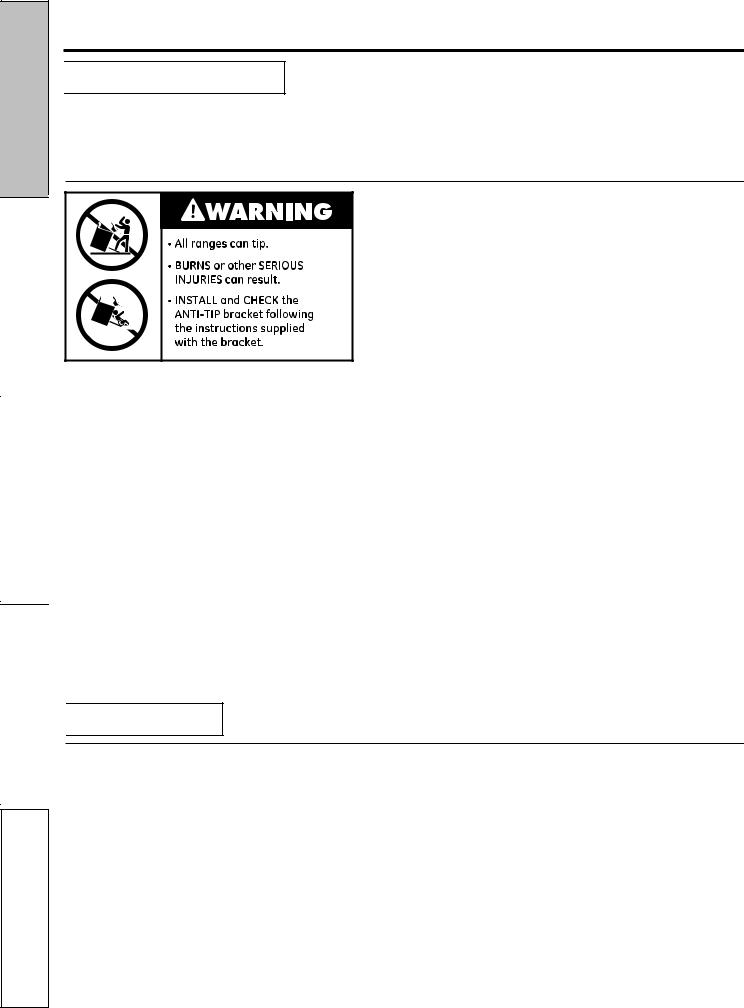
Consumer Support Troubleshooting Tips Care and Cleaning Operating Instructions Safety Instructions
IMPORTANT SAFETY INFORMATION.
READ ALL INSTRUCTIONS BEFORE USING.

 WARNING
WARNING
Read all safety instructions before using the product. Failure to follow these instructions may result in fire, electric shock, serious injury or death.
ANTI-TIP DEVICE
To reduce the risk of tipping the range, the range must be secured by a properly installed anti-tip bracket. See installation instructions shipped with the bracket for complete details before attempting
to install.
For Freestanding Ranges:
To check if the bracket is installed and engaged properly, remove the storage drawer or kick panel and look underneath the range
to see that the leveling leg is engaged in the bracket. On models without a storage drawer or kick panel, carefully tip the range forward. The bracket should stop the range within 4 inches. If it
does not, the bracket must be reinstalled. If the range is pulled from the wall for any reason, always repeat this procedure to verify the range is properly secured by the anti-tip bracket.
Never completely remove the leveling legs or the range will not be secured to the anti-tip device properly.
For Slide-In Ranges:
To check if the bracket is installed and engaged properly, remove the storage drawer or kick panel and look underneath the range to see that the leveling leg is engaged in the bracket.
For Drop-In Ranges:
To check if the bracket is installed and engaged properly, lower
the oven door and gently apply medium force at the handle end until movement of the range is detected. Continue pressing until the anti-tip bracket is engaged and movement stops. A small amount of movement is acceptable at the back of the range top, but it should be stable and not tip once the anti-tip bracket is engaged. If it does not, the bracket must be reinstalled.
If you did not receive an anti-tip bracket with your purchase, call 1.800.626.8774 to receive one at no cost (in Canada, call 1.800.561.3344). For installation instructions of the bracket, visit GEAppliances.com (in Canada, GEAppliances.ca).

 WARNING IMPORTANT SAFETY NOTICE
WARNING IMPORTANT SAFETY NOTICE
The California Safe Drinking Water and Toxic Enforcement Act requires the Governor of California to publish a list of substances known to the state to cause cancer, birth defects or other reproductive harm, and requires businesses to warn customers of potential exposure to such substances.
The fiberglass insulation in self-clean ovens gives off a very small amount of carbon monoxide during the cleaning cycle. Exposure can be minimized by venting with an open window or using a ventilation fan or hood.
2
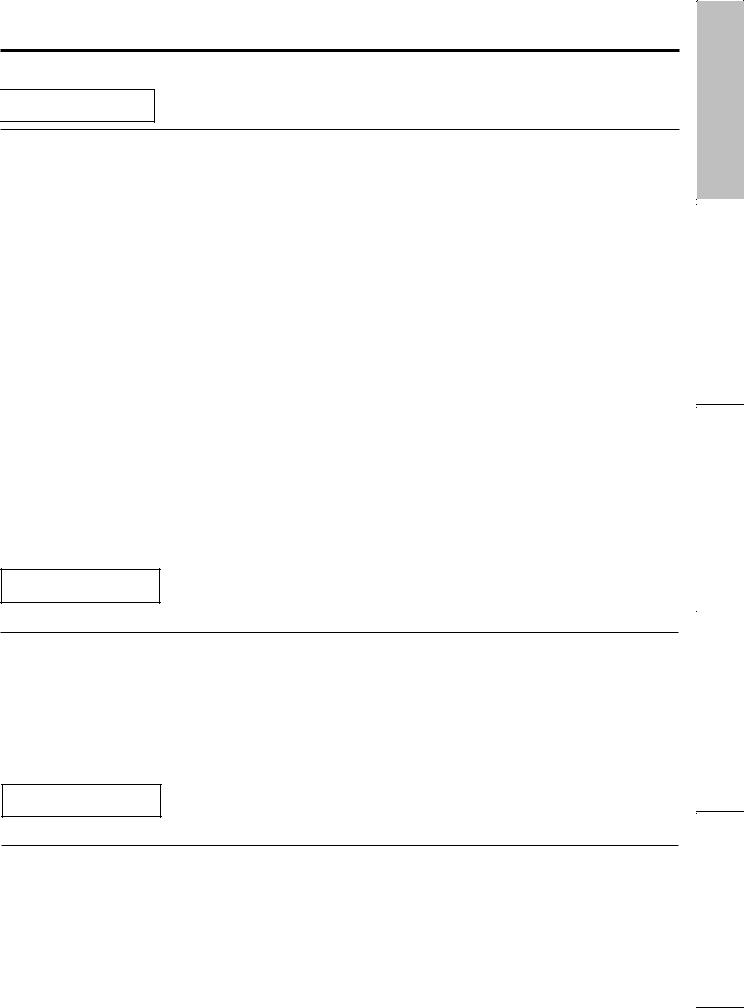
GEAppliances.com

 WARNING GENERAl SAFETY INSTRuCTIONS
WARNING GENERAl SAFETY INSTRuCTIONS
■Use this appliance for its intended purpose as described in this Owner’s Manual.
■Be sure your appliance is properly installed and grounded
by a qualified installer in accordance with the provided installation instructions.
■Do not attempt to repair or replace any part of your range unless it is specifically recommended in this manual. All other servicing should be transferred to a qualified technician.
■Before performing any service, unplug the range or disconnect the power supply at the household distribution panel by removing the fuse or switching off the circuit breaker.
■Do not leave children alone—children should not be left alone or unattended in an area where an appliance is in use. They should never be allowed to climb, sit or stand on any part of the appliance.
■CAUTION: Do not store items of interest to children above a range or on the backguard of a range—children climbing on the range to reach items could be seriously injured.
■Use only dry pot holders—moist or damp pot holders on hot surfaces may result in burns from steam. Do not let pot holders touch hot surface units or heating elements. Do not use a towel or other bulky cloth in place of pot holders.
■Never use your appliance for warming or heating the room.
■Do not touch the surface units, the heating elements or the interior surface of the oven. These surfaces may be hot enough to burn even though they are dark in color. During and after use, do not touch, or let clothing or other flammable materials contact the surface units, areas nearby the surface units or any interior area of the oven; allow sufficient time for cooling first. Other surfaces of the appliance may become hot enough to cause burns. Potentially hot surfaces include the cooktop, areas facing the cooktop, oven vent opening, surfaces near the opening and crevices around the oven door.
■Do not heat unopened food containers. Pressure could build up and the container could burst, causing an injury.
■Avoid scratching or impacting glass doors, cooktops or control panels. Doing so may lead to glass breakage. Do not cook on a product with broken glass. Shock, fire or cuts may occur.
■Cook meat and poultry thoroughly—meat to at least an internal temperature of 160°F and poultry to at least an internal temperature of 180°F. Cooking to these temperatures usually protects against foodborne illness.
 WARNING kEEP FlAMMABlE MATERIAlS AWAY FROM
WARNING kEEP FlAMMABlE MATERIAlS AWAY FROM
ThE RANGE.
■Do not store or use flammable materials in an oven or near the cooktop, including paper, plastic, pot holders, linens, wall coverings, curtains, drapes and gasoline or other flammable vapors and liquids.
■Never wear loose-fitting or hanging garments while using the appliance. These garments may ignite if they contact hot surfaces, causing severe burns.
■Do not let cooking grease or other flammable materials accumulate in or near the range. Grease in the oven or on the cooktop may ignite.
■Clean ventilating hoods frequently. Grease should not be allowed to accumulate on the hood or filter.
 WARNING IN ThE EVENT OF A FIRE, TAkE ThE FOllOWING STEPS TO PREVENT ThE FIRE FROM SPREADING:
WARNING IN ThE EVENT OF A FIRE, TAkE ThE FOllOWING STEPS TO PREVENT ThE FIRE FROM SPREADING:
■Do not use water on grease fires. Never pick up a flaming pan. Turn the controls off. Smother a flaming pan on a surface unit by covering the pan completely with a well-fitting lid, cookie sheet or flat tray. Use a multi-purpose dry chemical or foam-type fire extinguisher.
■If there is a fire in the oven during baking, smother the fire by closing the oven door and turning the oven off or by using a multi-purpose dry chemical or foam-type fire extinguisher.
■If there is a fire in the oven during self-clean, turn the oven off and wait for the fire to go out. Do not force the door open. Introduction of fresh air at self-clean temperatures may lead to a burst of flame from the oven. Failure to follow this instruction may result in severe burns.
3
Support Consumer Tips Troubleshooting Cleaning and Care Instructions Operating Instructions Safety
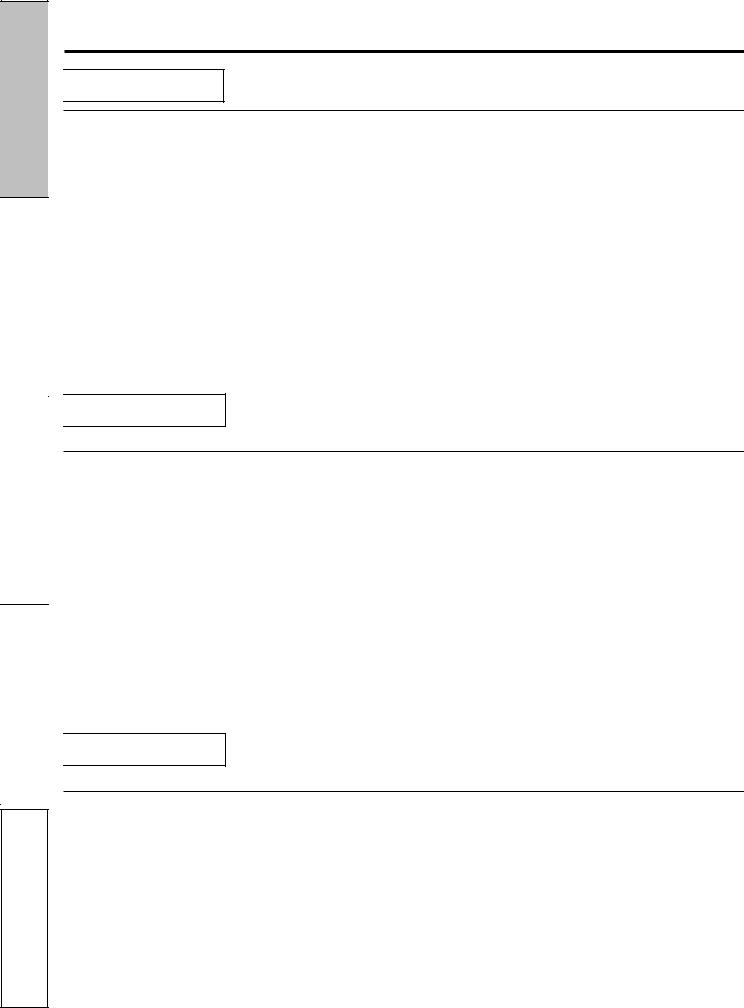
Consumer Support Troubleshooting Tips Care and Cleaning Operating Instructions Safety Instructions
IMPORTANT SAFETY INFORMATION. READ ALL INSTRUCTIONS BEFORE USING.

 WARNING COOkTOP SAFETY INSTRuCTIONS
WARNING COOkTOP SAFETY INSTRuCTIONS
■Never leave the surface units unattended at medium or high heat settings. Boilovers cause smoking and greasy spillovers that may catch on fire.
■Never leave oil unattended while frying. If allowed to heat beyond its smoking point, oil may ignite, resulting in fire that may spread to surrounding cabinets. Use a deep fat thermometer whenever possible to monitor oil temperature.
■To avoid oil spillover and fire, use a minimum amount of oil when shallow pan-frying and avoid cooking frozen foods with excessive amounts of ice.
■Use proper pan size—select cookware having flat bottoms large enough to cover the surface heating element. The use of undersized cookware will expose a portion of the surface unit to direct contact and may result in ignition of clothing. Proper relationship of cookware to surface unit will also improve efficiency.
■Only certain types of glass, glass/ceramic, earthenware or other glazed containers are suitable for cooktop service; others may break because of the sudden change in temperature.
■To minimize the possibility of burns, ignition of flammable materials and spillage, the handle of a container should be turned toward the center of the range without extending over nearby surface units.
■When preparing flaming foods under a hood, turn the fan on.

 WARNING RADIANT COOkTOP SAFETY INSTRuCTIONS
WARNING RADIANT COOkTOP SAFETY INSTRuCTIONS
(some models)
■Use care when touching the cooktop. The glass surface of the cooktop will retain heat after the controls have been turned off.
■Do not cook on a broken cooktop. If glass cooktop should break, cleaning solutions and spillovers may penetrate the broken cooktop and create a risk of electric shock. Contact a qualified technician immediately.
■Avoid scratching the glass cooktop. The cooktop can be scratched with items such as knives, sharp instruments, rings or other jewelry and rivets on clothing.
■Do not place or store items that can melt or catch fire on the glass cooktop, even when it is not being used. If the cooktop is inadvertently turned on, they may ignite. Heat from the cooktop or oven vent after it is turned off may cause them to ignite also.
■Use CERAMA BRYTE® ceramic Cooktop Cleaner and CERAMA BRYTE® Cleaning Pad to clean the cooktop. Wait until the cooktop cools and the indicator light goes out before cleaning. A wet sponge or cloth
on a hot surface can cause steam burns. Some cleaners can produce noxious fumes if applied to a hot surface. Note: Sugar spills are an exception. They should be scraped off while still hot using an oven mitt and a scraper. See the Cleaning the glass cooktop section for detailed instructions.
■Read and follow all instructions and warnings on the cleaning cream label.

 WARNING COIl COOkTOP SAFETY INSTRuCTIONS
WARNING COIl COOkTOP SAFETY INSTRuCTIONS
(some models)
■Do not immerse or soak the removable surface units. Do not put them in a dishwasher. Do not self-clean the surface units in an oven. Doing so may cause them to fail, presenting a burn or fire hazard.
■To avoid the possibility of a burn or electric shock, always be certain that the controls for all surface units are at the OFF position and all coils are cool before attempting to lift or remove a coil surface unit.
■Be sure the drip pans are not covered and are in place. Their absence during cooking could damage range parts and wiring.
■Do not use aluminum foil to line the drip pans. Foil can trap heat or melt, resulting in damage to the product and a shock or fire hazard.
4
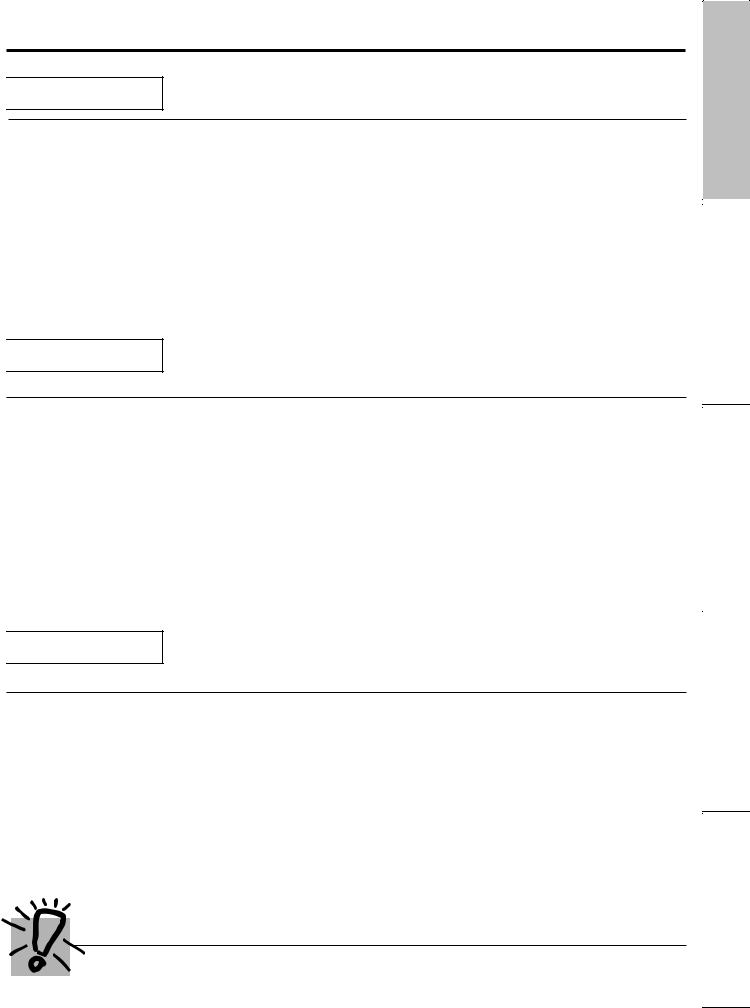
GEAppliances.com

 WARNING OVEN SAFETY INSTRuCTIONS
WARNING OVEN SAFETY INSTRuCTIONS
■Stand away from the range when opening the oven door. Hot air or steam which escapes can cause burns to hands, face and/or eyes.
■Keep the oven vent unobstructed.
■Keep the oven free from grease buildup. Grease in the oven may ignite.
■Place oven racks in desired location while oven is cool. If rack must be moved while oven is hot, do not let pot holder contact hot heating element in oven.
■When using cooking or roasting bags in the oven, follow the manufacturer’s directions.
■Pull the oven rack to the stop-lock position when loading and unloading food from the oven. This helps prevent burns from touching hot surfaces of the door and oven walls.
■Do not leave items such as paper, cooking utensils or food in the oven when not in use. Items stored in an oven can ignite.
■Do not use aluminum foil to line the oven bottom. Foil can trap heat or melt, resulting in damage to the product and a shock or fire hazard.

 WARNING SElF-ClEANING OVEN SAFETY INSTRuCTIONS
WARNING SElF-ClEANING OVEN SAFETY INSTRuCTIONS
(Some models)
The self-cleaning feature operates the oven at temperatures high enough to burn away food soils in the oven. Follow these instructions for safe operation.
■Before operating the self-clean cycle, remove pans, shiny metal oven racks and other utensils from the oven. Only gray porcelain-coated oven racks may be left in the oven. Do not use self-clean to clean other parts, such as drip pans or bowls.
■Before operating the self-clean cycle, wipe grease and food soils from the oven. Excessive amount of grease may ignite, leading to smoke damage to your home.
■If the self-cleaning mode malfunctions, turn the oven off and disconnect the power supply. Have it serviced by a qualified technician.
■Do not clean the door gasket. The door gasket is essential for a good seal. Care should be taken not to rub, damage or move the gasket.
■Do not use oven cleaners. No commercial oven cleaner or oven liner protective coating of any kind should be used in or around any part of the oven.
■Do not use aluminum foil to line the oven bottom. Foil can trap heat or melt, resulting in damage to the product and a shock or fire hazard.

 WARNING WARMING DRAWER/lOWER OVEN DRAWER SAFETY INSTRuCTIONS (some models)
WARNING WARMING DRAWER/lOWER OVEN DRAWER SAFETY INSTRuCTIONS (some models)
■The purpose of the warming drawer is to hold hot cooked foods at serving temperature. Bacteria will grow in food while it is below 140°F. Do not put cold food in warming drawer. Do not heat food for more than 2 hours. Failure to follow these instructions may result in foodborne illness.
■Do not leave paper products, plastics, canned food or combustible materials in the drawer. They may ignite.
■Do not touch the heating element or the interior surface of the drawer. These surfaces may be hot enough to cause burns.
■Use care when opening the drawer. Open the drawer a crack and let hot air or steam escape before removing or replacing food. Hot air or steam that escapes can cause burns to hands, face and/or eyes.
■Do not use aluminum foil to line the lower drawer. The foil will trap heat below, and upset the performance of the oven. Foil can melt and permanently damage the drawer bottom. Damage from improper use of aluminum foil is not covered by the product warranty.
 READ AND FOllOW ThIS SAFETY INFORMATION CAREFullY.
READ AND FOllOW ThIS SAFETY INFORMATION CAREFullY.
SAVE THESE INSTRUCTIONS
5
Support Consumer Tips Troubleshooting Cleaning and Care Instructions Operating Instructions Safety
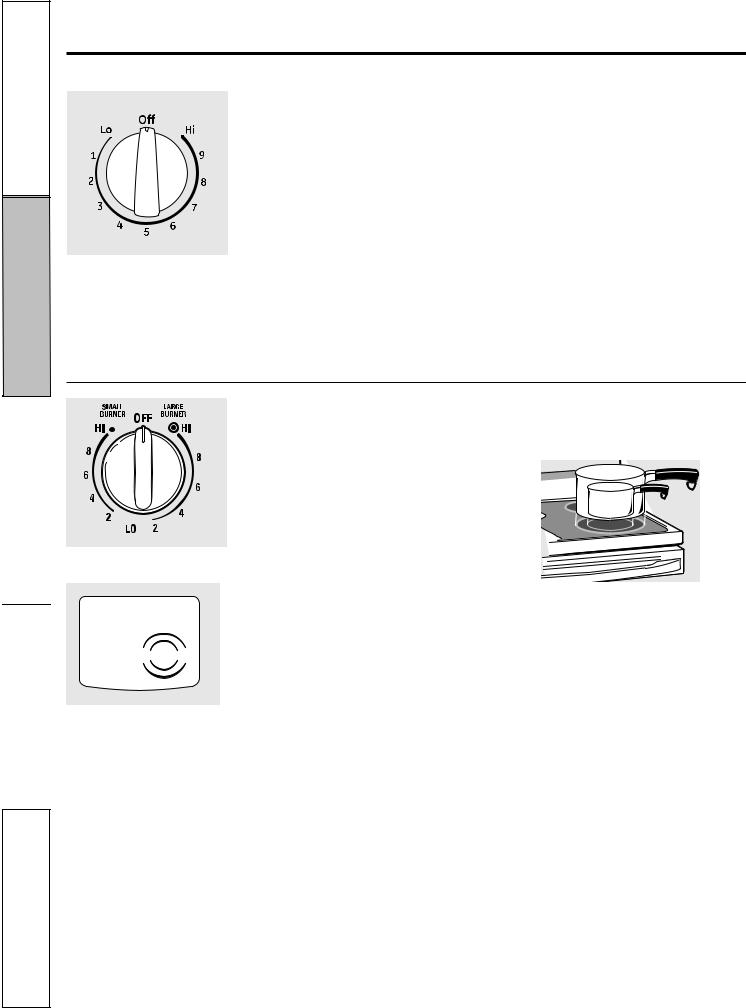
InstructionsSafety
snI urt itc sno
epO tar gni
Cleaningand
Care
TipsTroubleshooting
SupportConsumer
Using the surface units.
Throughout this manual, features and appearance may vary from your model.
Be sure you turn the control knob to Off when you finish cooking.
How to Set
Push the knob in and turn in either direction to the setting you want.
At both Off and Hi the control clicks into position. You may hear slight clicking
sounds during cooking, indicating the control is keeping the power level you set.
Indicator Lights
(on radiant glass models only)
A HOT SURFACE or HOT COOKTOP
(depending on model) indicator light will glow when any radiant element is turned on and will remain on until the surface is cool enough to touch.
A SURFACE UNIT on or BURNER ON
(depending on model) indicator light will glow when any surface unit is on.
NOTE: The SURFACE UNIT or BURNER ON indicator light may glow between the surface control settings of Lo and Off, but there is no power to the surface units.
Dual Surface Unit and Control Knob
(on some models)
The right front surface unit has 2 cooking sizes (6” and 9” or 9” and 12”) to select from
so you can match the size of the unit to the size of the cookware you are using.
To use the small surface unit, turn the
control knob counterclockwise to the
SMALL BURNER settings.
On some models.
To use the large surface unit, turn the control knob clockwise to the LARGE BURNER settings.
On some models.
6

Using the radiant surface units. (on some models) |
GEAppliances.com |
|
|
Never cook directly on the glass. Always use cookware.
OFF CENTER
Always place the pan in the center of the surface unit you are cooking on.
DRAGGING
About the radiant surface units…
The radiant cooktop features heating units beneath a smooth glass surface.
NOTE: A slight odor is normal when a new cooktop is used for the first time. It is caused by the heating of new parts and insulating materials and will disappear in a short time.
The surface unit will cycle on and off to maintain your selected control setting.
It is safe to place hot cookware from the oven or surface on the glass surface when the surface is cool.
Even after the surface units are turned off, the glass cooktop retains enough heat to continue cooking. To avoid over-cooking, remove pans from the surface units when the food is cooked. Avoid placing anything on the surface unit until it has cooled completely.
Do not slide cookware across the cooktop because it can scratch the glass—the glass is scratch resistant, not scratch proof.
■Water stains (mineral deposits) are removable using the cleaning cream or full-strength white vinegar.
■use of window cleaner may leave an iridescent film on the cooktop. The cleaning cream will remove this discoloration.
■Don’t store heavy items above the cooktop. If they drop onto the cooktop, they can cause damage.
■Do not use the surface as a cutting board.
Temperature Limiter
Every radiant surface unit has a temperature limiter.
The temperature limiter protects the glass cooktop from getting too hot.
The temperature limiter may cycle the units off for a time if:
■The pan boils dry.
■The pan bottom is not flat.
■The pan is off center.
■There is no pan on the unit.
7
Support Consumer Tips Troubleshooting Cleaning and Care Instructions Operating Instructions Safety
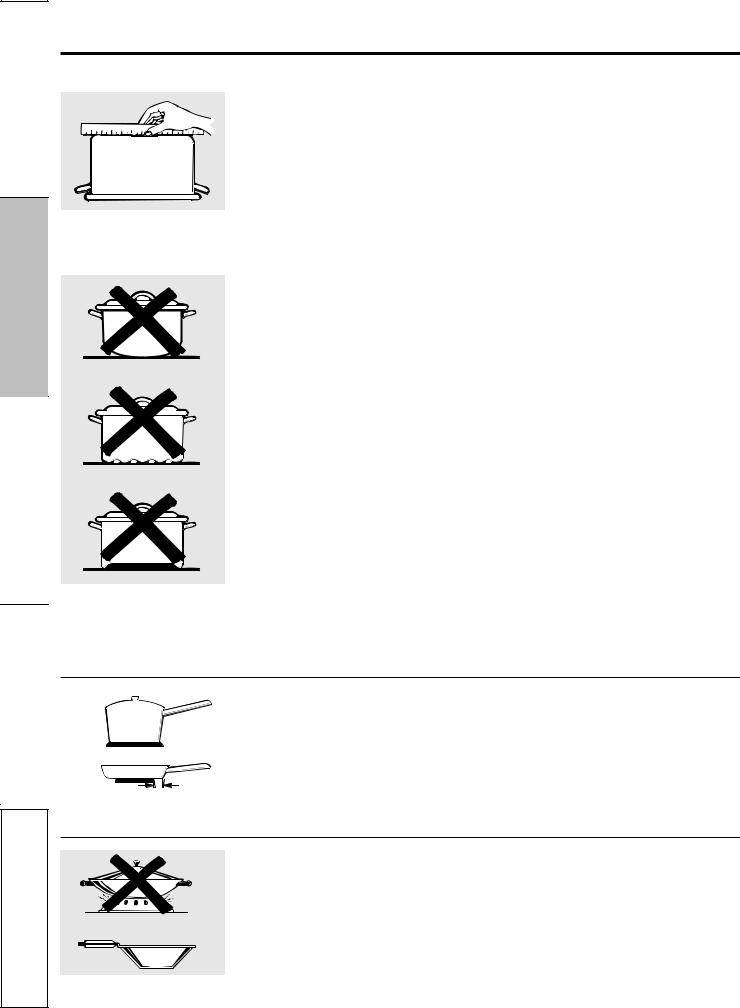
Consumer Support Troubleshooting Tips Care and Cleaning Operating Instructions Safety Instructions
Selecting types of cookware.
The following information will help you choose cookware which will give good performance on glass cooktops.
Check pans for flat bottoms by using a straight edge.
Pans with rounded, curved, ridged or warped bottoms are not recommended.
Stainless Steel: recommended
Aluminum:
heavy weight recommended
Good conductivity. Aluminum residues sometimes appear as scratches on the cooktop, but can be removed if cleaned immediately. Because of its low melting point, thin-weight aluminum should not be used.
Copper Bottom: recommended
Copper may leave residues which can appear as scratches. The residues can be removed, as long as the cooktop is cleaned immediately. However, do not let these pots boil dry. Overheated metal can bond to glass cooktops. An overheated copper bottom pot will leave a residue that will permanently stain the cooktop if not removed immediately.
Porcelain Enamel Covered Cast Iron: recommended
As long as the cookware is covered completely with porcelain enamel, this cookware is recommended. Caution is recommended for cast-iron cookware that is not completely covered with smooth porcelain enamel, as it may scratch the glass-ceramic cooktop.
Glass-ceramic:
usable, but not recommended
Poor performance. May scratch the surface.
Stoneware:
usable, but not recommended
Poor performance. May scratch the surface.
Home Canning Tips:
Be sure the canner is centered over the surface unit.
Make sure the canner is flat on the bottom.
Use recipes and procedures from reputable sources. These are available from manufacturers such as Ball® and Kerr® and the Department of Agriculture Extension Service.
To prevent burns from steam or heat, use caution when canning.
The following information will help you choose cookware which will give good performance on coil cooktops.
|
|
Surface Cookware Tips |
|
|
|
|
|
Use mediumor heavy-weight cookware. |
|
|
Aluminum cookware conducts heat faster |
|
|
than other metals. Cast-iron and coated |
|
|
cast-iron cookware are slow to absorb heat, |
|
1″ |
but generally cook evenly at low to medium |
|
heat settings. Steel pans may cook unevenly |
|
|
|
|
Not over 1 inch |
|
if not combined with other metals. |
For best cooking results, pans should be flat on the bottom. Match the size of the saucepan to the size of the surface unit. The pan should not extend over the edge of the surface unit more than 1 inch.
Wok Cooking
We recommend that you use only a flatbottomed wok. They are available at your local retail store.
Do not use woks that have support rings. Use of these types of woks, with or without the ring in place, can be dangerous.
Use only flat-bottomed woks.
Placing the ring over the surface unit will cause a buildup of heat that will damage the porcelain cooktop. Do not try to use such woks without the ring. You could be seriously burned if the wok tips over.
8
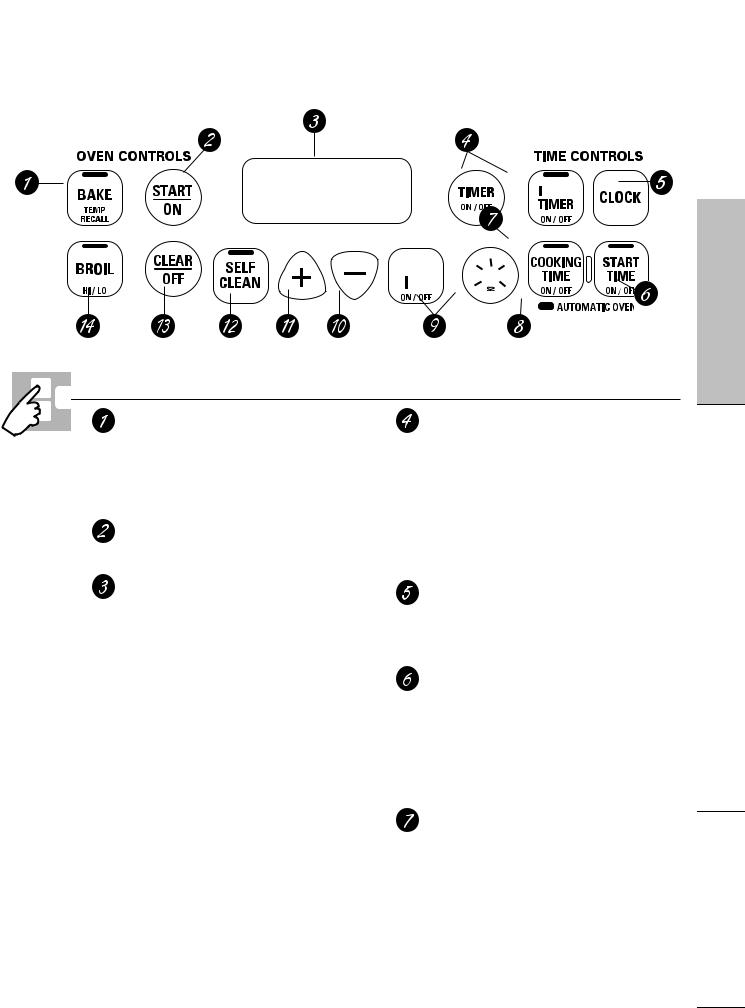
Using the oven controls. (on some models) |
GEAppliances.com |
|
|
Throughout this manual, features and appearance may vary from your model.
or 



 or
or 


Oven Control, Clock and Timer Features and Settings
BAkE/TEMP RECAll Pad
Touch this pad to select the bake function.
BAkE light
Flashes while in edit mode—you can change the oven temperature at this point. Glows when the oven is in bake mode.
START/ON Pad
Must be touched to start any cooking or cleaning function.
Display
Shows the time of day, oven temperature, whether the oven is in the bake, broil or selfcleaning mode and the times set for the timer or automatic oven operations. The display will show PRE while preheating. When the oven reaches the selected temperature, the oven control will beep and the display will show the oven temperature.
If “F– and a number or letter” flash in the display and the oven control signals, this indicates a function error code.
If your oven was set for a timed oven operation and a power outage occurred, the clock and all programmed functions must be reset.
The time of day will flash in the display when there has been a power outage. Reset the clock.
If the function error code appears during the selfcleaning cycle, check the oven door latch. The latch handle may have been moved, even if only slightly, from the latched position. Make sure the latch is moved to the right as far as it will go.
Touch the CLEAR/OFF pad. Allow the oven to cool for one hour. Put the oven back into operation. If the function error code repeats, disconnect the power to the range and call for service.
kITChEN TIMER ON/OFF or TIMER ON/OFF pad
Touch this pad to select the timer feature. Then touch the + and – pads to adjust the timer.
TIMER light
Flashes while in edit mode—you can change the set time at this point. Glows when the timer has been activated. Flashes again when the time has run out until the control is reset.
ClOCk Pad
To set the clock, press this pad twice and then press the + and – pads. The time of day will flash in the display when the oven is first turned on.
START TIME ON/OFF Pad (on some models)
Use along with the COOKING TIME ON/OFF or SELF CLEAN pads to set the oven to start and stop automatically at a time you set.
START TIME light
Flashes while in edit mode—you can change the start time at this point. Glows when the function has been activated.
COOkING TIME ON/OFF Pad (on some models)
Touch this pad and then touch the + or – pads to set the amount of time you want your food to cook. The oven will shut off when the cooking time has run out.
COOkING TIME light
Flashes while in edit mode—you can change the set time at this point. Glows when the function has been activated. Flashes again when the time has run out until the control is reset.
Support Consumer Tips Troubleshooting Cleaning and Care Instructions Operating Instructions Safety
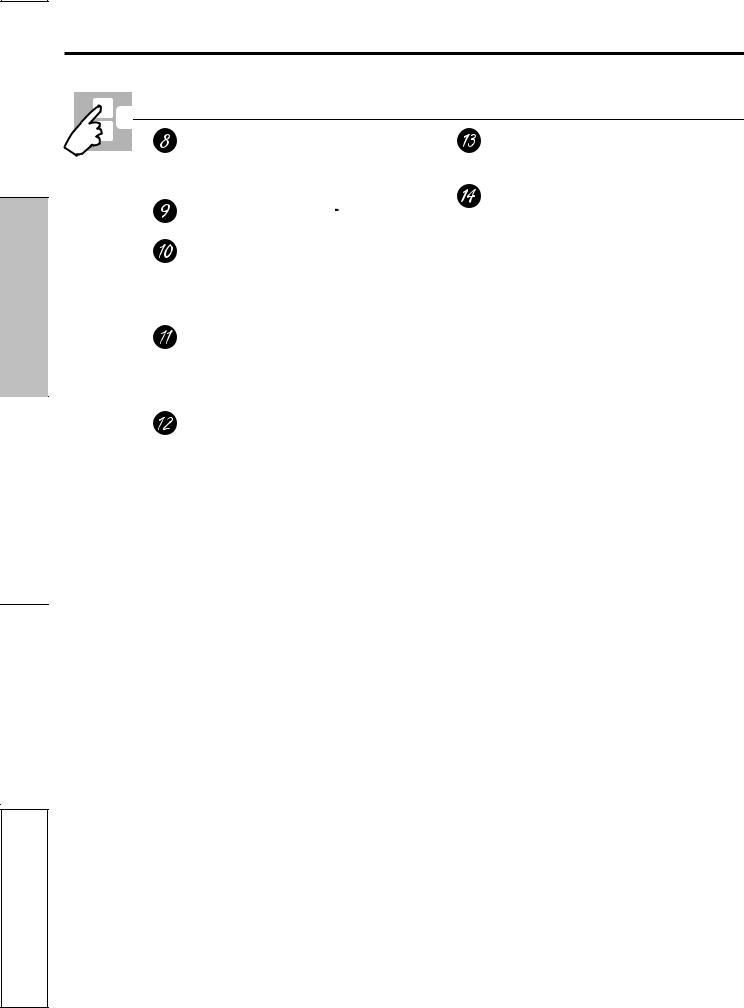
Consumer Support Troubleshooting Tips Care and Cleaning Operating Instructions Safety Instructions
Using the oven controls. (on some models)
Oven Control, Clock and Timer Features and Settings
AuTOMATIC OVEN light (on some models)
This lights anytime the oven has been programmed using the COOKING TIME or START TIME functions.
OVEN lIGhT ON/OFF or 

 Pad
Pad
Touch this pad to turn the oven light on or off.
– Pad
Short taps to this pad will decrease the time or temperature by small amounts. Touch and hold the pad to decrease the time or temperature by larger amounts.
+ Pad
Short taps to this pad will increase the time or temperature by small amounts. Touch and hold the pad to increase the time or temperature by larger amounts.
SElF ClEAN Pad (on some models)
Touch this pad to select the self-cleaning function. See the using the self-cleaning oven section.
ClEAN light
Flashes while in edit mode—you can change the length of time for the self-clean cycle at this point. Glows when the oven is in the self-clean cycle. After the self-clean cycle, the light will turn off. Unlatch the door.
ClEAR/OFF Pad
Touch this pad to cancel ALL oven operations except the clock and timer.
BROIl hI/lO Pad
Touch this pad to select the broil function.
BROIl light
Flashes while in edit mode—you can switch from HI to LO BROIL at this point. Glows when the oven is in broil mode.
Indicator lights (on some pads)
EDIT mode lasts several seconds after the last pad press. START TIME ON/OFF and COOKING TIME ON/OFF will be the only pads lit if either of these options is selected. (Example: START TIME is selected with BAKE—the START TIME pad will remain lit until the clock reaches the programmed time, at which point it will turn off and the BAKE/TEMP RECALL pad light will light up).
10
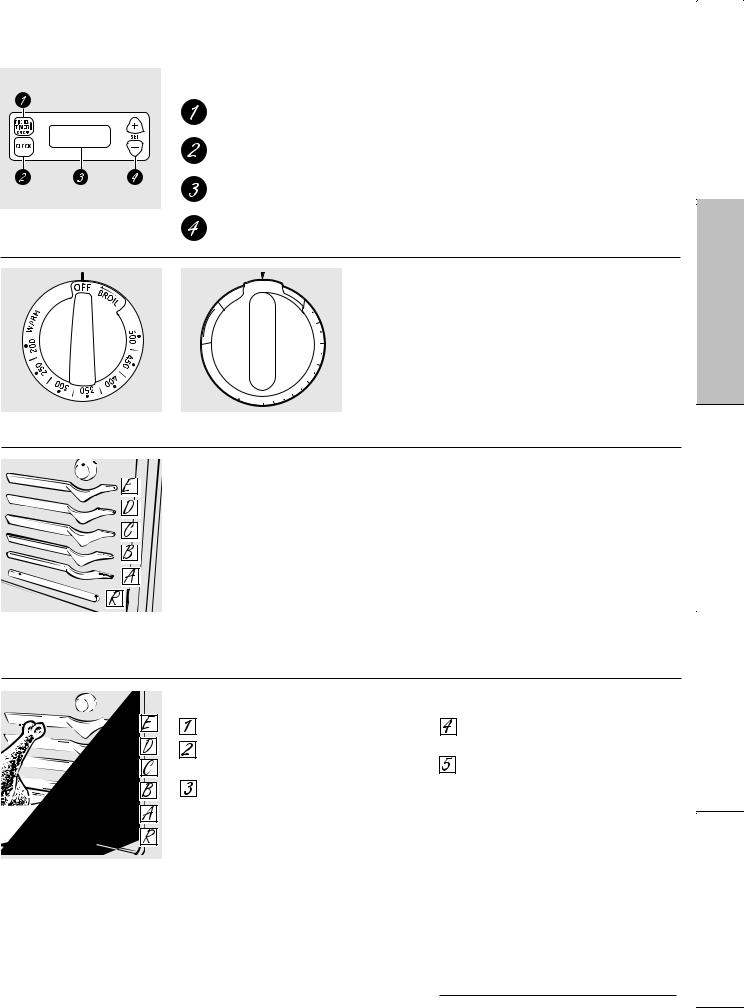
Using the oven. |
GEAppliances.com |
|
|
Clock and Kitchen Timer (on some models)
kITChEN TIMER ON/OFF Pad
Touch this pad to select the timer feature.
ClOCk Pad
Touch this pad before setting the clock.
Display
Shows the time of day and the time set for the timer, cook time or start time.
Appearance may vary. |
SET +/- Pads |
These pads allow you to set the clock and timer.
LE C
A
N
OFF
2 |
|
|
0 |
|
|
0 |
||
|
|
2 |
|
|
5 |
|
|
0 |
|
|
3 |
|
|
0 |
|
|
0 |
0 |
5 |
3 |
|
||
|
|
|
|
|
|
|
4 |
|
|
|
|
0 |
LI |
|
|
|
0 |
|
|
5 |
||
O |
|
|
||
|
R |
005 |
0 |
4 |
|
B |
|
|
|
Oven Temperature Knob (on some models)
Turn this knob to the setting you want.
■ The oven cycling light comes on during cooking.
(On some models— |
(On some models— |
appearance will vary) |
appearance will vary) |
The oven has 5 rack positions.
It also has a special low rack position (R) for extra large items, such as a large turkey.
Before you begin…
To avoid possible burns, place the racks in the desired position before you turn the oven on.
The racks have stop-locks, so that
when placed correctly on the rack supports (A through E), they will stop before coming completely out, and will not tilt.
When placing and removing cookware, pull the rack out to the bump on the rack support.
To remove a rack, pull it toward you, tilt the front end up and pull it out.
To replace, place the end of the rack (stop-locks) on the support, tilt up the front and push the rack in.
NOTE: The rack is not designed to slide out at the special low rack (R) position.
The oven has a special low rack (R) position just above the oven bottom. Use it when extra cooking space is needed, for example, when cooking a large turkey. The rack is not designed to slide out at this position.
How to Set the Oven for Baking or Roasting (on models without an oven temperature knob)
Touch the BAKE pad.
Touch the + or – pads until the desired temperature is displayed.
Touch the START/ON pad.
The oven will start automatically. The display will show PRE while preheating. When the oven reaches the selected temperature, the oven control will beep and the display will show the oven temperature.
To change the oven temperature during BAkE cycle, touch the BAKE pad and then the + or – pads to get the new temperature.
Check food for doneness at minimum time on recipe. Cook longer if necessary.
Touch the CLEAR/OFF pad when baking is finished and then remove the food from the oven.
Type of Food |
Rack Position |
|
|
|
|
Frozen pies (on cookie sheet) |
C |
|
|
|
|
Angel food cake, |
B |
|
bundt or pound cakes |
|
|
|
|
|
Biscuits, muffins, brownies, |
B or C |
|
cookies, cupcakes, |
|
|
layer cakes, pies |
|
|
|
|
|
Casseroles |
B or C |
|
|
|
|
Turkey |
R or A |
|
|
|
|
Roasting |
R, A or B 11 |
|
|
||
Support Consumer Tips Troubleshooting Cleaning and Care Instructions Operating Instructions Safety
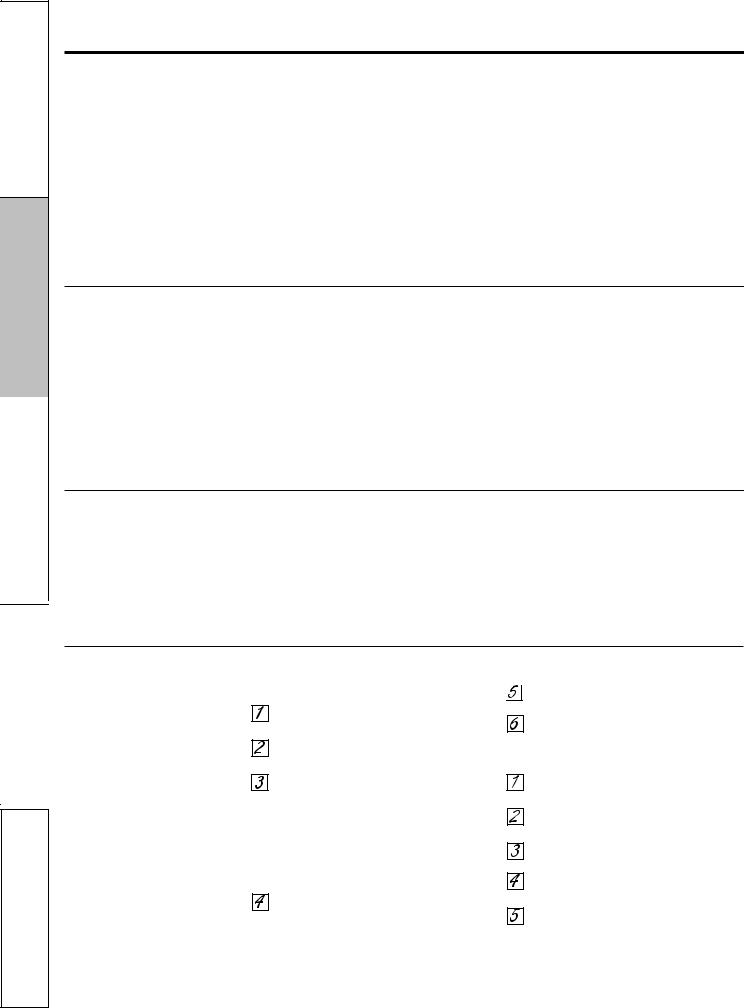
Consumer Support Troubleshooting Tips Care and Cleaning Operating Instructions Safety Instructions
Using the oven.
Type of Margarine Will Affect Baking Performance!
Most recipes for baking have been developed using high fat products such as butter or margarine (80% fat). If you decrease the fat, the recipe may not give the same results as with a higher fat product.
Recipe failure can result if cakes, pies, pastries, cookies or candies are made with low fat spreads. The lower the fat content of a spread product, the more noticeable these differences become.
Federal standards require products labeled “margarine” to contain at least 80% fat by weight. Low-fat spreads, on the other hand, contain less fat and more water. The high moisture content of these spreads affects the texture and flavor of baked goods. For best results with your old favorite recipes, use margarine, butter or stick spreads containing at least 70% vegetable oil.
Preheating and Pan Placement
Preheat the oven if the recipe calls for it. To preheat, set the oven at the correct temperature. Preheating is necessary for good results when baking cakes, cookies, pastry and breads.
On some models, the display will show “PRE” while preheating. When the oven reaches the selected temperature, the oven control will beep and the display will show the oven temperature.
For ovens without a preheat indicator light or tone, preheat 10 minutes.
Baking results will be better if baking pans are centered in the oven as much as
possible. Pans should not touch each other or the walls of the oven. If you need to use two racks, stagger the pans so one is
not directly above the other, and leave approximately 11⁄2″ from the front
of the pan to the front of the rack.
Aluminum Foil
Do not use aluminum foil to line oven bottoms. The foil will trap heat below and upset the performance of the oven. Foil can melt and permanently damage the oven bottom. Damage from improper use of aluminum foil is not covered by the product warranty
Foil may be used to catch spills by placing a sheet on a lower rack, several inches below the food .Do not use more foil than necessary and never entirely cover an oven rack with aluminum foil. Keep foil at least 1-1/2” from oven walls to prevent poor heat circulation.
If your range is connected to 208 volts, rare steaks
may be broiled by preheating the broiler and positioning the oven rack one position higher.
How to Set the Oven for Broiling
On models without an oven temperature knob:
Place the meat or fish on a broiler grid in a broiler pan.
Follow suggested rack positions in the
Broiling Guide.
Leave the door open to the broil stop position. The door stays open by itself, yet the proper temperature is maintained in the oven.
Use LO Broil to cook foods such as poultry or thick cuts of meat thoroughly without over-browning them.
Touch the BROIL HI/LO pad once for HI BROIL.
To change to LO Broil, touch the Broil HI/LO pad again.
Touch the START/ON pad.
When broiling is finished, touch the CLEAR/OFF pad.
On models with an oven temperature knob:
Place the meat or fish on a broiler grid in a broiler pan.
Follow suggested rack positions in the Broiling Guide.
Close the oven door.
Turn the Oven Temperature Knob to BROIL.
When broiling is finished, turn the Oven Temperature Knob to OFF.
12
